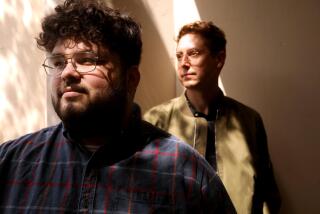Next to the Southern Pacific Railroad tracks...
Next to the Southern Pacific Railroad tracks at the edge of Chinatown is a forgotten jewel of the city--a fading brick building belonging to the Capitol Milling Co. that is the oldest commercial structure in Los Angeles.
For 162 years--the last 110 under the ownership of the same two families--the three-story brick mill has produced flour for the city’s bakeries.
Through three generations of Loews and Levis, the mill has served such companies as Ralphs Grocery Co. and Foix French Bakery.
“It’s provided a good livelihood,” said Stephen N. Loew Jr., the current president of Capitol Milling and a grandson of the company’s founder.
The brick mill, at 1231 N. Spring St., was built in 1831, 19 years before the incorporation of the city, just north of what was then known as El Pueblo de La Reina de Los Angeles. The bricks were brought from Philadelphia and the millstones were imported from France.
The mill was built by Massachusetts sea captain Abel Stearns, who settled in Los Angeles and became the largest landowner in Southern California. It was first powered by water that flowed from a man-made channel running along Alameda and North Spring streets, known as the Zanja Madre, or Mother Ditch.
The company had two other owners before it was purchased on April 18, 1883, by a young German-born merchandiser named Jacob Loew.
Loew had arrived in Los Angeles County in 1872. He bought a sheep ranch in Downey and set up a small general store with a partner.
His foray into ranching ended in disaster after 10 years when his sheep inexplicably began dying by the hundreds.
Loew was devastated and sold his grazing land for less than 25 cents an acre. It was only years later, after oil wells began sprouting on his former property, that he discovered what had killed his sheep. They had been poisoned by oil seeping into the water.
According to the Loew and Levi families, Loew later came to laugh at the strange misfortune that caused him to lose money in both sheep and oil.
After selling his ranch, Loew moved back to Los Angeles and bought the mill on Spring Street. Within two years, he married Emily Newmark, daughter of historian Harris Newmark, best remembered as the author of “Sixty Years in Southern California.” Loew teamed up with a nephew, Herman Levi, who had just arrived from Germany. Levi, too, married a Newmark, a granddaughter of Harris.
Loew and Levi immediately began to expand the flour mill, adding new facilities and installing a state-of-the-art 150-horsepower steam engine.
The mill soon tripled its output, producing 150 barrels, or 29,400 pounds, of flour a day. Loew and a friend, John Foix, owner of Foix French Bakery, negotiated their business over beers at a local tavern.
In his later years, Loew was troubled by health problems. After suffering two strokes, he grew increasingly despondent. On April 20, 1921, Loew locked himself in his office at Capitol Milling and shot himself in the head. He was 74.
Herman Levi took over the business. During Levi’s tenure, the mill was remodeled, the plant switched from steam power to electricity and production increased to 107,800 pounds of flour a day.
Today, the office decor retains some of the charm of the 1920s. Old flour sacks have been framed and hung in a conference room down the hall from oak-paneled offices that were decorated by Barker Bros. in 1922. A ring used to tether horses is still attached to the building. The original millstones were donated in 1920 to the Los Angeles County Natural History Museum.
Today, Capitol Milling Co. churns out up to 400,000 pounds of flour a day with modern equipment. But two warehouses and the three-story brick mill remain from 1831.
The company recently completed earthquake-strengthening of the old buildings. Stephen Loew Jr. said no one has ever considered tearing them down.
More to Read
Start your day right
Sign up for Essential California for news, features and recommendations from the L.A. Times and beyond in your inbox six days a week.
You may occasionally receive promotional content from the Los Angeles Times.





